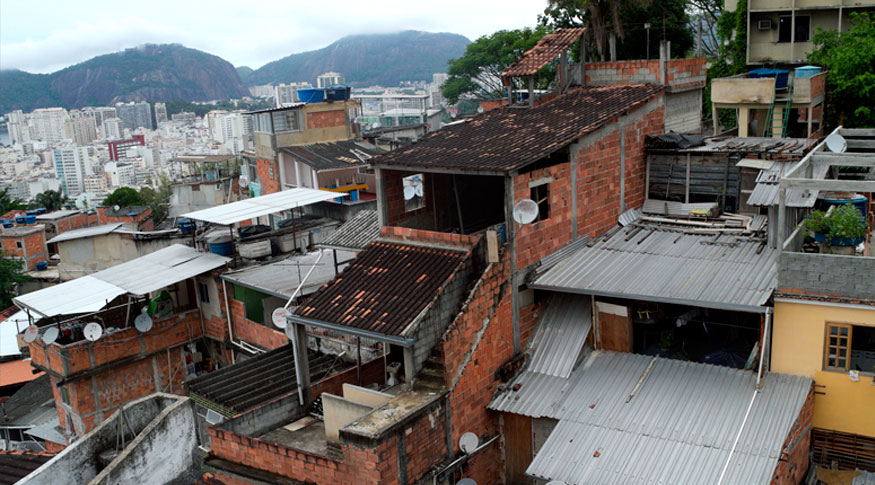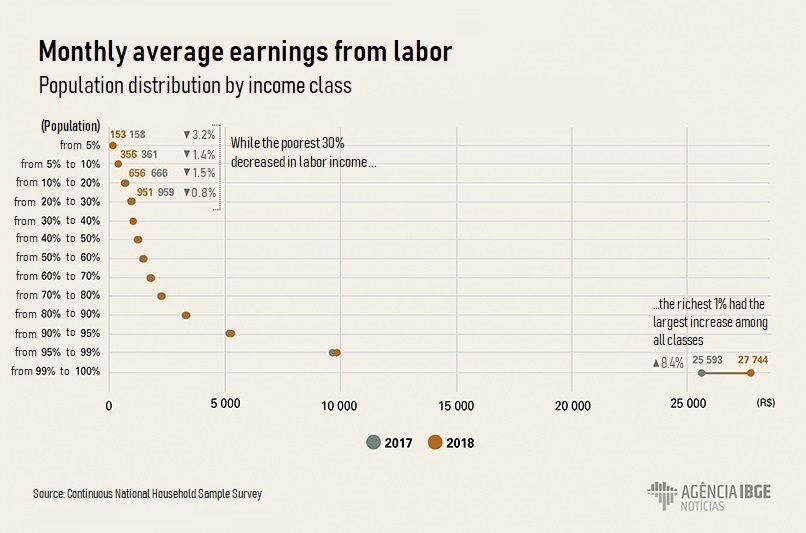PNAD Contínua
Earnings from labor of richest 1% is 34 times higher than the half poorest
October 16, 2019 10h00 AM | Last Updated: October 21, 2019 04h13 PM

The monthly average earnings of the richest 1% population was nearly 34 times higher than the half poorest in 2018. This means that the parcel with the highest income gained R$27,744 per month, on average, whereas those 50% less favored earned R$820.

The increase of 8.4% in the income of the richest persons and the drops in the earnings of the classes that comprise the 30% poorest contributed to this picture, compared with 2017. The information comes from the Earnings from All Sources module of the Continuous National Household Sample Survey - Continuous PNAD, released today (16) by the IBGE.

The survey also pointed out that the 10% poorest population held 0.8% of the wage bill, while those richest 10% concentrated 43.1%. The per capita household real monthly average wage bill, which was R$264.9 billion in 2017, increased to R$277.7 billion in 2018.
The average earnings from labor in Brazil for persons aged 14 years and over stayed at R$2,234, above the initial value of the series in 2012 (R$2,133), though below that registered in 2014, which was R$2,279. In the Northeast, the average earnings were R$1,479, whereas they hit R$2,572 in the Southeast.
Between 2017 and 2018, the Northeast was the only region where the earnings from labor decreased. "The earnings from labor corresponds to nearly three quarters of the total earnings of the households. A labor market in crisis, where persons are leaving their jobs to work in other jobs with lower wages, causes an impact in the total earnings", explained Maria Lucia Vieira, manager of the Continuous PNAD.
The Gini Index, which measures economic concentration and inequality, varying from zero (maximum equality) to one (maximum inequality), hit 0.509 in 2018 for earnings from labor. The indicator was 0.508 in Brazil in 2012, then it decreased to 0.494 in 2015 and increased once again. "These changes in the Gini Index are quite related to the fluctuations of the income of the richer persons", commented Adriana Beringuy, an IBGE analyst.
Nevertheless, such increase in the inequality was not uniform in the entire country. In the Northeast, the index fell from 0.531 in 2017 to 0.520 in 2018. "In the Southeast, those 1% with the highest earnings from labor increased 17.8%. In this same period, those richest 1% dropped 16.5% in the Northeast. As a result, inequality in the Northeast is more related to the drop in the earnings from labor of those richer than to the improvement in the life conditions of the poorer" said Beringuy.
Population that earns retirements and pensions reaches 14.6%
Besides earnings from labor, which represent nearly three quarters of the total received by the population per month, the survey also investigates other sources of income, like retirements, rentals and leases, pensions, allowances and other earnings, like social programs and profitability of financial applications.
Retirements and pensions stood out, hitting R$1,872 in 2018, the highest average among the other sources surveyed. This means an increase of 3.3% over 2017 and of 7.3% over 2012. Of the total population, 14.6% earned such benefits in 2018, whereas this proportion was 13.1% in 2012.
"The proportion of persons with earnings from labor dropped, and it is related to the loss of jobs. Conversely, the proportion of retirements has been improving, which could be related to more persons searching for this benefit or to demographic components, so much that it is stronger in the South and Southeast, where the population is older", said Vieira.
In the South, the population that earns retirements and pensions hit 18.3%, while it reached 15.8% in the Southeast.
Number of persons benefiting from Bolsa Família reduces to 13.7%
The survey also pointed out that the proportion of households that received earnings from the Bolsa Família Program fell from 15.9% in 2012 to 13.7% in 2018. This percentage remained virtually stable with a slight drop in 2013 (15.7%), a decline that accelerated in 2014 (14.9%) and 2015 (14%).
The household monthly average earnings of those receiving cash from the Bolsa Família also dropped, changing from R$368 to R$341, after hitting the top of R$398 in 2014. The figures are quite below the household real monthly average earnings of those not benefiting from the program: R$1,565.
The survey also unveils that those benefiting from the social program have less access to basic sanitation services – water, sewage disposal and garbage collection.
Among those with the Bolsa Família, 71.7% had water supply in general against 88.1% of those not receiving the benefit. Only 37.6% of those benefiting from the program have access to sewage disposal with collection network or septic tank against 70.9% of the rest of the population. And 75.7% count on garbage collection, below those not benefited (93.6%).




















